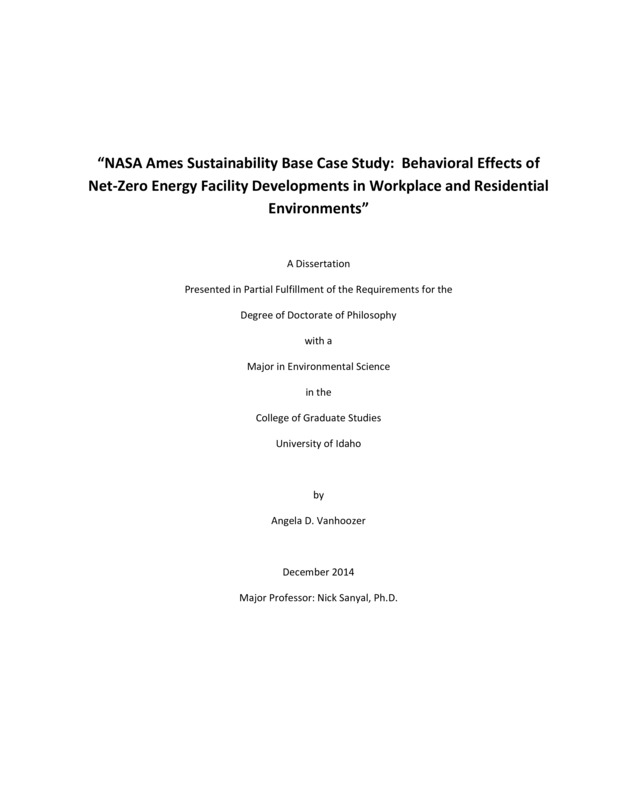NASA Ames Sustainability Base Case Study: Behavioral Effects of Net-Zero Energy Facility Developments in Workplace and Residential Environments
Vanhoozer, Angela Dawn. (2014). NASA Ames Sustainability Base Case Study: Behavioral Effects of Net-Zero Energy Facility Developments in Workplace and Residential Environments. Theses and Dissertations Collection, University of Idaho Library Digital Collections. https://www.lib.uidaho.edu/digital/etd/items/vanhoozer_idaho_0089e_10482.html
- Title:
- NASA Ames Sustainability Base Case Study: Behavioral Effects of Net-Zero Energy Facility Developments in Workplace and Residential Environments
- Author:
- Vanhoozer, Angela Dawn
- Date:
- 2014
- Keywords:
- environmental behavior net-zero energy post occupancy evaluation
- Program:
- Environmental Science
- Subject Category:
- Architecture; Behavioral sciences; Environmental science
- Abstract:
-
This research details a three-part inter-disciplinary mixed methods case study of the occupant experience in the built environment at NASA Ames Research Center's Sustainability Base. Sustainability Base is the federal government's second net-zero energy facility and the first living test-bed for building energy research and design. Our research first described changes in occupant satisfaction after moving from traditional offices to the high performance work environment. Through post-occupancy evaluation methods, including surveys and physical instrumentation, recommendations were made to improve acoustic and lighting conditions in Sustainability Base, and to explore potential utilization of occupant feedback in external research partnerships as part of the living test-bed model. The second part of the study employed survey research methods to quantify changes in energy conservation awareness, norms, and home behaviors for occupants after two years of working in the building. Results indicated increases in awareness of workplace energy sources, workplace social conservation norms, and influences of workplace on home conservation behaviors. The third part of the study explored the influences of communication channels in Sustainability Base on the diffusion of technological innovations in the work environment and in the homes of occupants. The Diffusion of Innovations (DIT) theoretical framework was used to explore innovation characteristics of the building from the occupant perspective. Findings indicated trade-offs in relative advantages between traditional and high performance work environments, such as increased natural lighting and lack of privacy. Incompatibility in high performance building design standards, organizational infrastructure, and health and safety requirements presented operational challenges for facilities managers. Public showcasing of the building generated positive response from occupants, and adaptability of innovations to the home was indicated, particularly for residential plug load management. However, adaptability of systems in Sustainability Base to home environments was limited by cost and feasibility issues. Findings for the study contributed new methods of post-occupancy evaluation to the architectural field, established behavioral connections between workplace and home environments, and provided a framework for evaluating the implementation and utilization of high performance buildings.
- Description:
- doctoral, Ph.D., Environmental Science -- University of Idaho - College of Graduate Studies, 2014
- Major Professor:
- Sanyal, Nick
- Committee:
- Haglund, Bruce; Heinse, Robert; Thorsteinson, Todd
- Defense Date:
- 2014
- Identifier:
- Vanhoozer_idaho_0089E_10482
- Type:
- Text
- Format Original:
- Format:
- application/pdf
- Rights:
- In Copyright - Educational Use Permitted. For more information, please contact University of Idaho Library Special Collections and Archives Department at libspec@uidaho.edu.
- Standardized Rights:
- http://rightsstatements.org/vocab/InC-EDU/1.0/

